Wishaw
Wishaw is a post-industrial large town in North Lanarkshire, Scotland, on the edge of the Clyde Valley, 15 miles (24 km) south-east of Glasgow city centre.[3] The Burgh of Wishaw was formed in 1855; it formed a joint large burgh with its neighbour Motherwell from 1920 until its dissolution when Scottish local authorities were restructured in 1975. The town is part of the Motherwell and Wishaw constituency. It is one of the principal towns of Lanarkshire and has the postal code of ML2 and the dialling code 01698.
| Wishaw | |
|---|---|
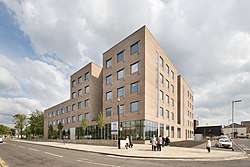   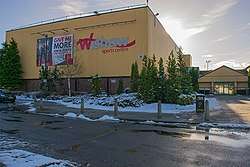 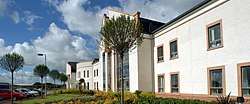 .jpg) From top : Wishaw Health Centre, Greenhead Park Nature Reserve, Beltane Park, Wishaw Sports Centre, University Hospital Wishaw, aerial view of Wishaw | |
 Wishaw 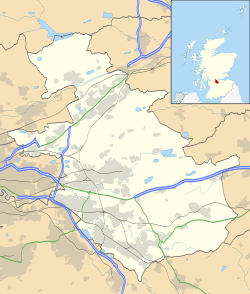 Wishaw Location within North Lanarkshire | |
| Population | 30,250 [2] (est. 2018) |
| Language | English, Scots |
| OS grid reference | NS795555 |
| • Edinburgh | 31 mi (50 km) |
| • London | 389 mi (626 km) |
| Council area | |
| Lieutenancy area | |
| Country | Scotland |
| Sovereign state | United Kingdom |
| Post town | WISHAW |
| Postcode district | ML2 |
| Dialling code | 01698 |
| Police | Scotland |
| Fire | Scottish |
| Ambulance | Scottish |
| UK Parliament | |
| Scottish Parliament | |
Wishaw had a population of 30,510 in 2016.[4][5][6] This makes it one of the largest towns in both North and South Lanarkshire. Itself, Wishaw is the 26th largest settlement in Scotland. Historically a mining and farming town, human presence in Wishaw dates back thousands of years, however in the 21st century serves as a vibrant commuter town and a growing center in the Central Belt. Along with its neighbours of Hamilton, Bellshill and Motherwell it forms part of the Greater Glasgow conurbation, which has a total population of around 1,670,000 (around a third of Scotland's population) as of 2019.[7]
Geography and climate
Wishaw lies within a very populated area in North Lanarkshire, which itself is the fourth largest local authority in Scotland (based on population). The main areas of Wishaw are: Cambusnethan, Coltness, Craigneuk, Gowkthrapple, Dimsdale, Greenhead, Wishawhill, Netherton, Pather and Waterloo. There are two adjoining villages, often included as part of the town for administrative purposes: Overtown and Newmains. The town is located in the relatively level Central Belt area of Scotland. While there are valleys and high moors within this area, there are no hills or summits over 1,640 feet.
Like the majority of Scotland, Wishaw has a temperate oceanic climate, with the Köppen climate classification of Cfb. This means that Wishaw experiences mild summers and cool winters, with the most rainfall coming between October and March. Snow, while not unheard of during winters, is not the norm. Most winters in Wishaw see around 10–20 days of snow. The warmest month on average is July, with an average daily temperature of 14.7 degrees C, while the coldest is January with an average daily temperature of 2.3 C.[8]
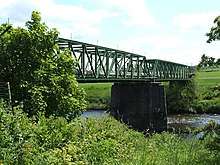
Wishaw lies on two rivers. These are the rivers of the Clyde and the South Calder Water, with the Clyde running near Overton and Netherton and the Calder further north, near Coltness and Newmains.
Etymology
It is not certain how Wishaw's name came into being. The town is possibly named after Wishaw House, built in the woods by the South Calder Water.[9] The house was probably built some time after the sale of the lands of Coltness, Wishaw, Watstein and Stain to the predecessor of Lord Belhaven:[10][11] Hamilton of Uddsten.[12] It was probably then that the estate was named. Other theories exist; it may be from the Old English for "Willow Wood". Others believe the name was originally Viashaw, meaning way or road through the wood, which would make sense as an ancient Roman road was built through the modern town. Yet another theory is that the name derives from "Wee Shaw", meaning small wood. The name may come from the Scottish Gaelic word "uisge", meaning water (which is where whisky derives its name), Therefore Wishaw could mean simply water. However all these theories have equal likelihood.
In Scottish Gaelic, the main name of the town is, Camas Neachdain [13]
History
Ancient and Roman history
The area of what is now Wishaw once lay on important Roman roads that ran through the areas of the Clyde (Latin - Cluta) and South Calder Water. In fact, the current Main Street is based on a road built by the Romans.[14] Another such road ran close to Wishaw House.[15] The Roman fort at nearby Bothwellhaugh (now Strathclyde Park) means the area would have been vital for supplying soldiers fighting the native Caledonians in the Highlands. The exact dates of the Roman occupation range from the first Roman invasion around 70 AD, and the final retreat of Roman legions from Scotland around the year 210 AD. Wishaw was in the region of the Brittonic Celts of ancient Britain, more specifically, the British Damnonii tribe controlled the land. It is likely that at this time the site of the modern town was covered by woodland, marshes and meadows. A small Celtic farming settlement may have existed in the area. Lanarkshire has been inhabited almost continuously since around 6500 BCE,[16] so it is possible that Wishaw could have been inhabited before the Roman arrival, but no such evidence has yet been found.
Medieval era
In the Early Middle Ages, where is now Wishaw fell under the rule of the Kingdom of Strathclyde, (Welsh - Terynas Ystrad Clud) however no settlement was recorded. Strathclyde then unified with Alba around 1000 AD, forming modern Scotland. The Strathclyde region spoke the now extinct Cumbric language and resisted Anglo-Saxon and later Viking invasions, however any potential inhabitants of where Wishaw is today would have been fully Gaelicised from around the 11th to the 13th centuries. The closest known village was Hamilton or Cadzow, as the Britons called it at the time, lying around 4 miles north west of Wishaw's present location.
Wishaw is not one of Scotland's medieval towns, but a settlement in the area dates back to the 12th century when a Christian monk named Nethan established a kirk dedicated to St. Michael by a bend (camas/cambo- in Cumbric or Gaelic) on the banks of the Clyde near what is now Netherton. The area then became known as the parish of Cambusnethan, and remained so until the Reformation. The site of the original church remains as a ruined burial ground,[17] including an impressive mausoleum to Lord Belhaven.[18] Anglicisation would have happened in the area some time around the 14th century. In 1303, a medieval document on the county of Lanark accounts "the farm of the vill of Weteshaw".[19] This is the earliest known use of a name similar to Wishaw. No archaeological evidence has yet to point to exact location of this medieval site or its remains. The village could have been abandoned due to the Black Death. The Cambusnethan/Wishaw area would have remained small in population, likely only totaling tens of people in farmsteads during the Middle Ages.
In a map of Lanarkshire[20] published in the 1500s, the names of areas such as Nothorton (Netherton), Camunethan (Cambusnethan), and Greenhead (Greenhead) all appear in the general location of Wishaw. In the modern day, these areas are all neighbourhoods of Wishaw.
Modern era
In the 18th century agriculture in the area consisted mainly of growing oats although some wheat and pear trees were cultivated.[21] Members of the Reformed Presbyterian Church took up the favourable terms of the proprietor to enable them to establish a congregation in Wishaw in 1792.[22] The village itself was laid out in 1794, named Cambusnethan, and later renamed Wishawtown.[23]
In 1801 the population of Wishaw was about 400 and that of the whole parish only 1972.[24] In the 1830s Lord Belhaven set up a distillery in Wishaw.[25] Other nineteenth century industries included coal mining, iron and steel making, foundry work, railway-waggon building and fire-clay making.[26] Wishaw grew dramatically in the 1830s, with railways and gasworks coming to the town, many collieries opening during this time period. By the time the Caledonian Railway's main line came through Wishaw in 1848 it was a major mining centre fueling an important part of Scotland's industrial heartland. There were also factories for needle-work and tambouring, and confectionery.[27] On 4 September 1855, the town was incorporated with the villages of Coltness and Stewarton to form the Burgh of Wishaw, with a population of approximately 5,000. Four years later, in 1859, St.Ignatius Parish Church was established, and the church built on Young Street, where it remains to this day. In 1882 Groome recorded that there were 5 schools in Wishaw as well as others in nearby villages.[28] During the Irish Famine, many Irish refugees settled in Central Scotland and many came to Wishaw. The descendants of these Irish Catholics can be found today in Wishaw's large Catholic population. One notable visitor to Wishaw in the middle of the 19th century was the Polish composer Frédéric Chopin.[29] Chopin was entertained at Wishaw house and played there for the family, the Hamiltons of Belhaven.[30]
During World War I, 3,050 men from the Wishaw area were drafted into the British Armed Forces. Many of these men were sent to the Western Front to fight the German Imperial Army. Many local men would be killed in action, and many would win war medals as altogether over 100 medals were given to Wishaw men for their heroic actions.
Again in World War II, Wishaw was vital to the British war effort as it was a hub for railways, coal mining and steelworks. American soldiers were stationed in Wishaw at some point during the war. The men from Wishaw who fought in WW2 mostly did so in Western Europe and in the North African Campaign. Despite the strategic value of the town, Wishaw was never targeted during The Blitz and survived the war undamaged.
As a result of its history as a steel manufacturing and mining community, Wishaw was also home to mining and industrial equipment manufacturers such as Anderson Boyes (now part of Long-Airdox) and Svedala, but both these businesses have since gone through changes leading to their movement away from these businesses and the Wishaw area. Former industrial employers in the area include many steelworks such as the former British Steel Corporation, Clyde Alloy, Bone Connell & Baxter, though most of these are now defunct due to the decline of the steel industry. The Wishaw/Motherwell area was heavily involved in the 1984-85 Miners strike. Wishaw and its nearby neighbour of Motherwell were once the centre of steel manufacture in Scotland, as both towns were located either side of the former Ravenscraig steelworks which closed in 1992. The (now-defunct) local firm of R Y Pickering & Co Ltd (later Norbrit-Pickering) built railway rolling stock (especially wagons) and many tramcars for tram systems throughout the UK. One of its last tramcar orders was for 10 double-decker trams for Aberdeen Corporation Tramways in 1949. In November 1996, the world's worst recorded outbreak of E. coli O157 occurred in the town, in which 21 people died and around 200 were infected.
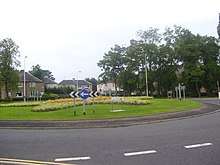
Recent decades
The town has recovered from the loss of industry such as steelworks and coal mines which closed mainly closed down in the 1980s and 1990s. Most of the late 1990s and 2000s were a recovery period of the town, as high unemployment and crime became an issue. However, in the 2010s, Wishaw's economy recovered and began growing again, just as Scotland's economy did. The 2010s were a time of great change for Wishaw, mostly for the better. The town is now looking ahead to better things in the future, after coming out of a difficult patch in its history. In the 2014 Scottish independence referendum, Wishaw along with its neighbour Motherwell, voted 52% in favour of Scottish independence, meanwhile 48% voted against independence.[31] On both the 2015 and 2017 general election, Wishaw and Motherwell voted for SNP.[32]
Throughout the 2010s, Wishaw underwent various regeneration efforts and new developments. On 15 April 2012, roadworks began in the town centre.[33] These roadworks finished in 2013. The roadworks changed the layout of most areas of the Main Street. In 2014, construction on a new housing estate in Coltness began. The construction was on behalf of Barratt Homes, and included new large homes mainly for families. The new area/development became known as Ravenwood. This year also marked the beginning of the construction of the new Holdsworth Centre and its adjacent car-park. The building opened in August 2015. In 2017, a JD Sports was built in the area near several other retail stores, such as McDonald's, Aldi and Home Bargains. This year also saw the renovation of the McDonald's, which occurred in May 2017.
These days, North Lanarkshire Council suggest that the majority of the biggest employers in the town are supermarkets, with the exceptions of Royal Mail, which has its main Scottish distribution centre at Shieldmuir and the NHS as a result of University Hospital Wishaw. There are many service industry businesses located in the town's industrial areas, though none with more than a few hundred employees.
During the COVID-19 pandemic, Wishaw has been a key area in the British government's response, due to University Hospital Wishaw being a major regional hospital. Wishaw entered full coronavirus lockdown on 23 March with the rest of the UK and remained so for 66 days, until the Scottish government entered "phase 1" of lifting coronavirus restrictions on May 28. [34]
Education
At present there are three high schools in the area: Clyde Valley High School in Overtown, and Coltness High School and St Aidan's High School, both in Coltness. St. Aidan's High School serves not only Catholic pupils from Wishaw, but nearby towns such as Newmains, Shotts and Carluke. St. Aidans, therefore has the highest number of pupils at around 1,100.
Primary schools in Wishaw include Calderbridge, St. Thomas', Thornlie, St. Aidan's, Cambusnethan, St. Ignatius' and Wishaw Academy (with both the latter two schools being a joint campus).
The town does not have a university or college at present, with the nearest college being Motherwell College, based in Ravenscraig, and the University of the West of Scotland (formerly Bell College of Technology) in Hamilton being the nearest university.
Health establishments
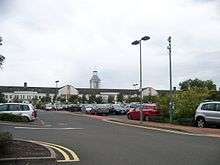
Wishaw has a general hospital, now known as University Hospital Wishaw, in the Craigneuk area. It serves nearby settlements such as Motherwell, Newmains and Shotts. It is one of three acute hospitals in Lanarkshire, the others being Monklands Hospital in Airdrie and Hairmyres Hospital in East Kilbride.
Also based in the town, on the site of the old town library in Kenilworth Avenue, is the Houldsworth Centre which houses a café, public toilet, Wishaw library and Wishaw Health Centre.[35] The centre opened in April 2015 along with a multi-storey car park.
Town centre
Main Street is the predominant shopping area in Wishaw. It is partly made up of major national stores such as Peacock's, Poundland, Iceland and Greggs
The Main Street shopping area also features small independent retailers. There are also many supermarkets in the area, with a new small format Asda in the eastern suburb of Newmains that opened on October 2007. A Tesco Extra superstore was also opened during November 2007, and is adjacent to the railway station, replacing the smaller Metro store on Main Street, about 150 metres (500 ft) from the new store. A 1991 built Morrisons (originally Safeway) exists on the eastern edge of the town centre. The original Safeway on Kirk Road, about 300 metres (1,000 ft) from the new store, was a small market style mall and hosted various stalls and a café. However, this mall closed on March 2009 and was converted back to supermarket form as B & M Bargains discount store. This has since closed and relocated to a larger property in the Craigneuk Retail Park. All three supermarkets mentioned have petrol stations situated next to them.
The shops themselves remained somewhat the same throughout the 2010s, although the WHSmith closed down and was replaced with a larger Poundland. The old Poundland became a charity shop for victims of stroke and heart disease. A second Costa Coffee opened up, with this one being near Greggs. Two ice cream shops opened and so did several takeaways. The only other changes were a few small businesses opening up, some closing down, and expansions or renovations
There is also an Aldi superstore in Glasgow Road that opened on September 2008, with the original store 150 metres (500 ft) away being converted into Sports Direct.
Wishaw also has the "Caledonian Centre", a shopping complex in the northern suburb of Craigneuk consisting of other national store chains such as Argos, Matalan, B & M, Pets at Home and The Range.
Improvements
The first stage of the modern town centre regeneration programme was completed in 2004, with a new car park being constructed between the local library and health centre and with the formation of a taxi rank adjacent to the library also a water fountain was put on the ground of Wishaw Library which looks like the old one which used to stand near the former Wishaw Health Centre.
A piece of eyesore land between Station Road and Alexander Street (the railway station and sports centre) was converted into a park and ride facility, as part of this programme. This has led to a decrease in railway parking and traffic next to the station. The facility was later increased in size as it was too small.
In late 2011, Kitchener Street was converted from a small neighbourhood to a main road, routing traffic away from the Main Street to Kenilworth Avenue, where a new roundabout was built. Lammermore Terrace, which was previously one-way, was converted into a two-way street.
In 2014 work on a new modern housing estate called Ravenwood began on the site of the old Lammermuir school, which became was renamed Calderbridge and moved to a new building 600m away. The neighbourhood was finished in 2016 and now consists of around 50 houses.
Religion
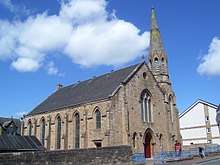
Wishaw has many churches in it of various kinds and denominations. There are several Church of Scotland congregations – serving principally the town centre are South Wishaw Parish Church and Wishaw Old Parish Church, and serving the outlying parts of Wishaw are – Cambusnethan North Church, Cambusnethan Old and Morningside Parish Church, Craigneuk and Belhaven Church, Coltness Memorial Church (Newmains) and St. Mark's Church (Coltness). The Church of Scotland "charges" have been reduced in recent years through the union of Thornlie and Chalmers Churches to form South Wishaw Parish Church, and the linkage of Wishaw Old Parish Church with that of Craigneuk and Belhaven Church who now share one minister.
The town also has a United Free Church, an Episcopal Church dedicated to St. Andrew, a Baptist church (both in Belhaven Terrace), a Gospel Hall (Ebenezer Gospel Hall), a Methodist church (now known as Netherton Methodist Church), a Christian Outreach Centre and 5 Catholic churches of the Roman Rite: St. Ignatius of Loyola (Young Street), St. Aidan's (Coltness), St. Thomas' (Caledonian Road), St. Brigid's (Newmains) and St. Patrick's (Shieldmuir).
The town has a large Catholic population, mainly coming from those of Irish, Polish, Italian and Lithuanian descent. This is common across most of Greater Glasgow.
Governance
Wishaw is represented by several tiers of elected government. North Lanarkshire Council, the unitary local authority for Wishaw, is based at Motherwell, and is the executive, deliberative and legislative body responsible for local governance. The Scottish Parliament is responsible for devolved matters such as education, health and justice,[36] while reserved matters are dealt with by the Parliament of the United Kingdom.
Westminster
The Motherwell and Wishaw constituency is represented in the UK Parliament by Marion Fellows MP (SNP).
Scottish Parliament
In the Scottish Parliament, the constituency is represented by Clare Adamson (SNP).
In addition to this, Wishaw is represented by seven regional MSPs from the Central Scotland electoral region.[37] They are: Linda Fabiani (Scottish National Party, SNP), Jamie Hepburn (SNP), Christina McKelvie (SNP), Margaret Mitchell (Scottish Conservative Party), Alex Neil (SNP), Hugh O'Donnell (Scottish Liberal Democrats), and John Wilson (SNP).
Local government
North Lanarkshire has many councillors; currently, the Labour group is in control of the council and the leader of the council is Jim Logue, councillor for Airdrie Central.[38]
Sports, restaurants and recreation
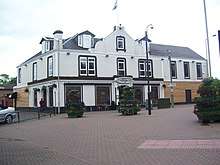
Leisure and entertainments
Wishaw has a very large Mecca Bingo hall in Kirk Road. In recent years, the town has turned into a nightspot when it comes to pubs and clubs that are on offer. The Commercial Hotel has a nightclub and also a restaurant, bar and hotel, with rooms and accommodation for overnight stay. Pubs include: Girdwood's', a well established and long running live music venue https://girdwoods.co.uk/', the Cross Keys, the Waverley ' and the Yard The Westend and The Corner which shut down in 2012 has being replaced with the bar-restaurant Corrigans. On Stewarton Street, near the town centre, there is an Irish pub named The Cross Keys Inn. The pub regularly shows Celtic games, as the majority of its customers are supporters of the club.
Eating establishments
Wishaw is not short of eating establishments, from small local cafes to international global chains such as McDonald's. As well as the Commercial, the town is home to a Wetherspoons restaurant, known as the Wishaw Malt, directly opposite the Mecca bingo. There is an Indian buffet restaurant, known as the Pink Turban, located in the Waterloo suburb. Wishaw has a McDonald's restaurant and a KFC restaurant (both located on Glasgow Road), which opened in 2004 and 1942 respectively. The grand opening of KFC was a joyous occasion with Frank Roy MP cutting the ribbon and also being the first person in Wishaw to sample a Zinger box meal. The main street also contains two national sandwich chains, Subway and Greggs. The town is also host to a modern Scottish restaurant called Artisan, which may have one of the largest ranges of whisky in Scotland. It also has large number of independent takeaway restaurants and cafes, most of which are located in the main street. The Cafe Shabbab is located in Newmains.
A Pizza Hut opened in 2017, located on Main Street from an old Blockbuster LLC and a Domino's opened in September 2018, in a previously abandoned shop on Kirk Road.
Sports facilities
There is no professional football team in Wishaw. Many of the town's residents are followers of Rangers, Celtic and near-neighbours Motherwell. There is however a junior football team, Wishaw, which plays its home games at Beltane Park, near to the town's sports centre. There is also a large juvenile football club, Wishaw Wycombe Wanderers, who have many registered young players, playing football in age groups from Under 6s to Under 21s.
Wishaw has a King George's Field in memorial to King George V, next to the town's hospital. This small park has two full-sized football pitches as well as a swing park and play area.
To the northwest of the town, there is a large golf course.
.jpg)
The town's municipal sports centre also includes two small swimming pools, badminton and martial arts facilities and gymnastic equipment. A full-length running track is also on site along with a full-sized football pitch. Long jump pits and throwing cages are also issued within the track. There are also 5-a-side astroturf pitches for football, where many local games are held. Elsewhere, all-weather pitches and a children's play area behind Morrison's have been closed for a new shared campus primary school by St. Ignatius Primary and Wishaw Academy Primary. The local council has made no announcement on whether these facilities will be replaced.
The town previously had a large swimming pool complete with a large spectator grandstand, an underwater viewpoint and diving facilities (with boards at 1.5m, 3m and 5m). This was closed during the late 1990s to make way for a much smaller facility on the site of the town's sports centre. The reason given for this decision was the cost of maintaining such a facility for a town as small as Wishaw. Over the years it had played host to many regional swimming events and also benefited from being within walking distance of the two main secondary schools in the area as well as a host of primary schools.
Wishaw General Hospital also has a heat pool for specialist physio treatment.
Town park
Wishaw also has a town park named after Lord Belhaven, Belhaven Park. It has a swing park with plenty of climbing frames and slides, and plenty of benches. There is a pathway at the back of the park which leads through the trees and into a council estate. In March 2011, the parks play-area underwent a significant upgrade.
Transport
Location grid
Bus
The town has a comprehensive bus network operated by First Glasgow. Other smaller providers include: JMB Travel, Stuart's, Henderson Travel, Coakley and Whitelaw's. Destinations that can be reached by bus from the town include:
Historically, bus services in the Wishaw area were operated by a local company, Hutchison's. Their distinctive blue and cream buses finally gave way in 2007 to a friendly takeover by one time rival First.
Despite initially closing the Hutchison depot in Overtown upon the takeover, and moving all staff and vehicles to Blantyre, First have since launched new services in the Wishaw area, that has required the re-opening of the depot and indeed a major recruitment campaign.
Wishaw was formerly served by an intensive network of services provided by McKindless. This company was wound up in 2010 following a tax investigation. This had the potential to leave many parts of Lanarkshire without a decent public transport link as McKindless had forced many other operators to abandon routes to places such as Lanark and Shotts. However, SPT and Irvine's and First stepped in to replace most services almost straight away.
Railway
Wishaw railway station on the Argyle line (running from Lanark and Carstairs to Milngavie and Dalmuir).
A half-hourly service provided by Abellio ScotRail connects Wishaw to places such as:
- Motherwell
- Carluke
- Hamilton
- Cambuslang
- Bellshill
- Uddingston
- Glasgow Central
Wishaw also has a second station, Shieldmuir railway station, serving the Craigneuk area of the town. There is also a twice daily service to Edinburgh Waverley.
Trains on the West Coast Main Line pass through the town at 115 mph, but no passenger service trains stop there, as the main Wishaw South railway station on the line closed in 1958.
Roads
Wishaw is on the A71, Edinburgh, Livingston and Kilmarnock road which links the town to the M74 as well as the A73 which links the town with the Borders regions and the M8.
Following a campaign by local politicians, the area is now well signposted from the nearby M8 and M74 motorways. This move was considered necessary as although the town is not considered a principal destination from either of these roads and therefore not included as standard on the signage, it is now the home to the main hospital for an area stretching right down the M74 corridor almost to the English border approximately 75 miles (120 km) away.
Airport
The nearest airport to Wishaw is Glasgow Airport at 20 miles (32 km) distant, though at 26 miles (42 km) Edinburgh Airport is not much further. Connections to both airports are only via the cities they serve as no direct public transport links are available.
People
Notable people from Wishaw include:
- Thomas Canfield Pomphrey, architect, was born here in 1881.[39]
- The Alexander Brothers, musicians and entertainers
- Joe Baker, footballer
- Andrew Barrowman, footballer
- John Cleland, motor racing champion
- Enrico Cocozza, underground filmmaker
- Colin Cramb, footballer
- Sir Samuel Curran, physicist, inventor of the scintillation counter, and founder of Strathclyde University
- Alan Fisher, journalist
- Tommy Gemmell, footballer
- Jim Graham, Washington, D.C. politician
- Roy Henderson, footballer
- John Higgins, world snooker champion
- Paul Higgins, actor and writer
- Derek Holmes, footballer
- The Jolt, 1970s pop group
- Lewis Macleod, footballer
- John Gibson Lockhart, biographer and novelist
- Stan McEwan, footballer
- Marie McLaughlin, opera singer
- Lee Miller, footballer
- Michael Moore, politician
- Deborah Orr, journalist and columnist
- Paul Quinn, footballer
- Charles Reid (photographer) Victorian Photographer
- Gordon Reid, actor
- Anne Sharp, opera singer
- Bill Scott, rugby player
- Alison Turriff, musician
- Frank S. Walsh, scientist
- Alex Wilson, footballer
- Thomas Winning, archbishop and cardinal
- Nicholas McDonald, Singer and runner-up of ITV's The X Factor
- Kieran Tierney, footballer for Arsenal and the Scotland national team
References
- Scots Language Centre: Scottish Place Names in Scots
- "UNITED KINGDOM: Council Areas and Major Cities in Scotland". Retrieved 12 August 2020.
- "25-inch O.S. Map with zoom and Bing overlay". National Library of Scotland. Ordnance Survey. Retrieved 30 December 2017.
- "Key Facts 2016 – Demography". North Lanarkshire Council. Retrieved 3 January 2018.
- "Estimated population of localities by broad age groups, mid-2012" (PDF). Retrieved 3 January 2018.
- Not including outlying villages Cleland, Gowkthrapple, Newmains and Overtown which are recorded separately.
- worldpopulationreview.com http://worldpopulationreview.com/world-cities/glasgow-population/. Retrieved 22 September 2019. Missing or empty
|title=(help) - "Wishaw climate: Average Temperature, weather by month, Wishaw weather averages - Climate-Data.org". en.climate-data.org. Retrieved 10 September 2019.
- "Wishaw House". Canmore. Historic Environment Scotland. Retrieved 6 January 2018.
- Pomphrey's directory of Wishaw and handbook of the parish of Cambusnethan: with Shotts supplement (3rd ed.). Wishaw: W. Pomphrey. 1893. pp. 22–24. Retrieved 5 January 2018.
- Johnston, G. Harvey (1909). The heraldry of the Hamiltons: with notes on all the males of the family, description of the arms, plates and pedigrees. Edinburgh: W. & A.K. Johnston. p. 75. Retrieved 6 January 2018.
- Livingstone, Archibald (1845). The new statistical account of Scotland (Vol 6 ed.). Edinburgh and London: William Blackwood and Sons. p. 612. Retrieved 3 January 2018.
- "Two Gaelic names of Wishaw".
- "Roman Roads in Wishaw". Wishaw Feature Page on Undiscovered Scotland.
- Anne S. robertson, s n miller (1937). The Roman Occupation of South Western Scotland.
- Anonymous (19 November 2015). "Mesolithis hunters arrive near Lanark". www.lanark.co.uk. Retrieved 14 October 2019.
- "Cambusnethan, St Michael's Church And Graveyard". Canmore. Historic Environment Scotland. Retrieved 6 January 2018.
- "Cambusnethan, St Michael's Graveyard, Belhaven And Stenton Mausoleum". Canmore. Historic Environment Scotland. Retrieved 6 January 2018.
- (PDF) https://www.electricscotland.com/history/records/bain/029BainVolumeTwoCalendarPart05.pdf. Missing or empty
|title=(help) - "View: [Glasgow and the county of Lanark] - Pont 34 - Maps by Timothy Pont". maps.nls.uk. Retrieved 4 September 2019.
- Lockhart, John (1791). The statistical account of Scotland. Drawn up from the communications of the ministers of the different parishes (Vol. XII, 1794 ed.). Edinburgh: W. Creech. pp. 569–571. Retrieved 5 January 2018.
- Brown, Peter (1859). Historical sketches of the parish of Cambusnethan. Wishaw: D. Johnston. p. 50. Retrieved 5 January 2018.
- Livingstone, Archibald (1845). The new statistical account of Scotland (Vol 6 ed.). Edinburgh and London: William Blackwood and Sons. p. 621. Retrieved 3 January 2018.
- Pomphrey's directory of Wishaw and handbook of the parish of Cambusnethan: with Shotts supplement (3rd ed.). Wishaw: W. Pomphrey. 1893. p. 16. Retrieved 5 January 2018.
- Livingstone, Archibald (1845). The new statistical account of Scotland (Vol 6 ed.). Edinburgh and London: William Blackwood and Sons. p. 622. Retrieved 3 January 2018.
- Mort, Frederick (1910). Lanarkshire. Cambridge: Cambridge University Press. p. 166. Retrieved 4 January 2018.
- Pomphrey's directory of Wishaw and handbook of the parish of Cambusnethan: with Shotts supplement (3rd ed.). Wishaw: W. Pomphrey. 1893. pp. 45–50. Retrieved 5 January 2018.
- Groome, Francis Hindes (1882). Ordnance gazetteer of Scotland : a survey of Scottish topography, statistical, biographical, and historical (Vol 1 ed.). Edinburgh: T.C. Jack. p. 226. Retrieved 5 January 2018.
- Zaluski, Iwo and Pamela (1993). The Scottish Autumn of Frederick Chopin. Edinburgh: John Donald Ltd. Retrieved 6 January 2018.
- Iwo Zaluski, Pamela Zaluski The Scottish Autumn of Frederick Chopin John Donald Publishers 1993 ISBN 9780859763899
- 12457 (18 September 2014). "Referendum result for North Lanarkshire". Government of the United Kingdom. Retrieved 2 June 2019.CS1 maint: numeric names: authors list (link)
- "Motherwell and Wishaw parliamentary constituency".
- Miller, Graham (17 April 2012). "Driving you crazy: Wishaw Main Street closes for roadworks". dailyrecord. Retrieved 2 June 2019.
- "Lifting of Scottish COVID restrictions". 29 May 2020.
- "Name for Wishaw health and council centre". NHS Lanarkshire. Retrieved 8 January 2018.
- "Reserved and devolved matters". Scotland Office. Archived from the original on 4 October 2006. Retrieved 14 November 2006.
- Paterson, Colin (6 May 2011). "Scottish Election 2011: Seven MSPs on Central Scotland list". Airdrie & Coatbridge Advertiser. Retrieved 10 August 2013.
- "Member and Committee Information". North Lanarkshire Council. Retrieved 6 August 2016.
- "Pomphrey, Tom". Archives and Collections: Glasgow School of Art. Retrieved 18 September 2015.
External links
- Wishaw High School Facebook page
- Wishaw High School Remembered – Website under construction
- Chisholm, Hugh, ed. (1911). . Encyclopædia Britannica. 28 (11th ed.). Cambridge University Press.
- History and Photographs of Wishaw Iron & Steel Works 1859 – 1930
- Scenes at West Cross Enrico Cocozza interviews local people.
- Scenes at West Cross Compilation of views around West Cross in Wishaw.[1]
| Wikimedia Commons has media related to Wishaw. |
- Cocozza, Enrico. "Scenes at West Cross". Moving Image Archive. National Library of Scotland. Retrieved 5 October 2019.
